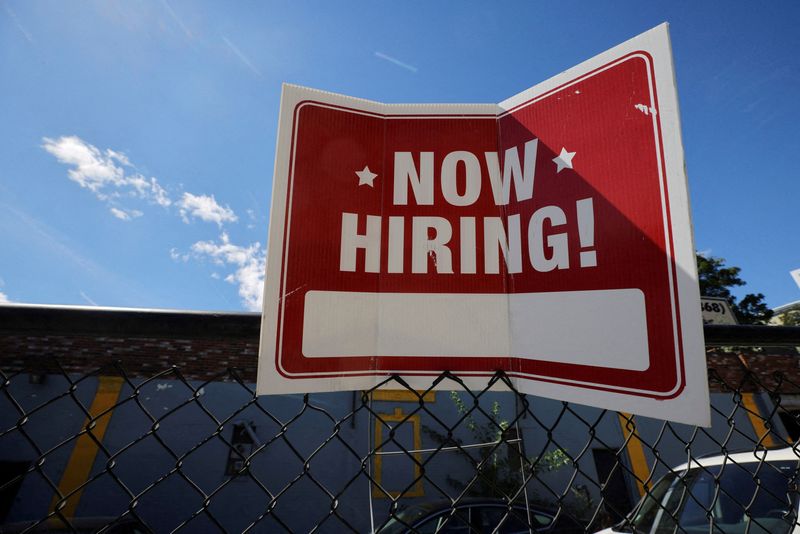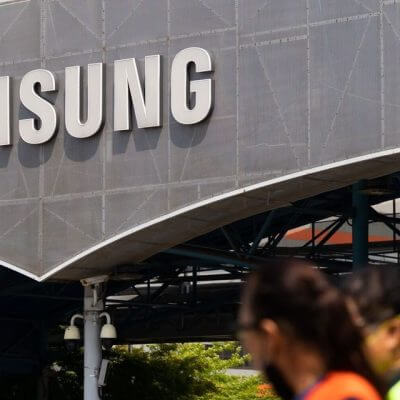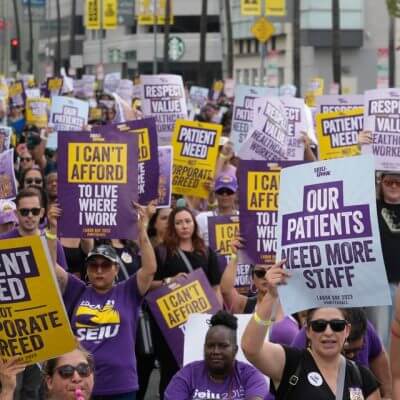
© Reuters. FILE PHOTO: A “now hiring” sign is displayed outside Taylor Party and Equipment Rentals in Somerville, Massachusetts, U.S., September 1, 2022. REUTERS/Brian Snyder
By Lucia Mutikani
WASHINGTON (Reuters) – U.S employers maintained a strong pace of hiring in March, pushing the unemployment rate down back to 3.5%, signs of labor market resilience that keep the Federal Reserve on track to raise interest rates one more time next month.
The Labor Department’s closely watched employment report on Friday showed annual wage gains slowing, but remaining too high to be consistent with the U.S. central bank’s 2% inflation target. As with most recent economic data, it was too early for financial market stress, triggered by the failure of two regional banks in March, to show up in the employment report.
“While this is an employment report not likely to cause alarm, per se, there is still no evidence policy is tight enough to slow demand in a meaningful way, either,” said Chris Low, chief economist at FHN Financial in New York.
Nonfarm payrolls increased by 236,000 jobs last month, the survey of establishments showed. Data for February was revised higher to show 326,000 jobs were added instead of 311,000 as previously reported.
Some of the slowdown in hiring reflected the fading boost from unseasonably mild weather in January and February.
Economists polled by Reuters had forecast payrolls rising 239,000. Estimates ranged from 150,000 to 342,000. The economy needs to create roughly 100,000 jobs per month to keep up with growth in the working-age population.
The leisure and hospitality accounted for the bulk of the employment gains, adding 72,000 jobs, most of the positions at restaurants and bars. Employment in the leisure and hospitality industry remains 368,000 below its pre-pandemic level.
Restaurants and bars have been the main drivers of job growth since the recovery from the pandemic.
Government employment increased by 47,000. Employment in government is 314,000 below its February 2020 level. There were increases in professional and business services hiring, as well as healthcare, transportation and warehousing. But manufacturing payrolls fell for a second straight month. Retailers shed 14,600 jobs, while construction employment decreased by 9,000.
The decline in the unemployment rate to 3.5% from 3.6% in February was despite 480,000 entering the labor force. The household survey from the which the unemployment rate is derived showed employment increasing 577,000 last month.
The dollar rose against a basket of currencies. U.S. Treasury prices fell.
Average hourly earnings rose 0.3% in March after gaining 0.2% in February. That lowered the annual increase in wages to 4.2% from 4.6% in February. Fed officials will now await inflation data later this month to gauge the impact of their year-long monetary policy tightening campaign.
Financial markets are leaning toward the U.S. central bank increasing rates by another 25 basis points at the May 2-3 policy meeting, according to CME Group’s (NASDAQ:) FedWatch tool.
The Fed last month raised its benchmark overnight interest rate by a quarter of a percentage point, but indicated it was on the verge of pausing further rate hikes in a nod to financial market stress. It has hiked its policy rate by 475 basis points since last March from the near-zero level to the current 4.75%-5.00% range.
The labor market is expected to considerably loosen up starting in the second quarter as companies respond more to slowing demand caused by the higher borrowing costs.
Credit conditions have also tightened, which could make it harder for small businesses and households to access funding.





